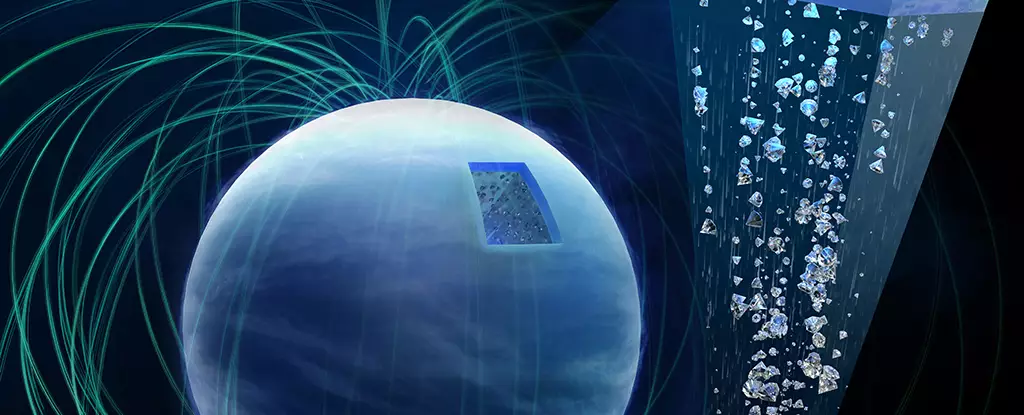Diamonds are known as one of the most precious and exquisite gemstones on Earth. However, a recent study suggests that diamond rain could be a common occurrence in the Universe, particularly on giant icy gas planets like Neptune and Uranus. This groundbreaking discovery not only deepens our understanding of local icy planets but also holds implications for similar processes on exoplanets beyond our Solar System.
Carbon can crystallize into diamonds under ultra-high temperatures and pressures found deep within the atmosphere of gas planets. These extreme conditions break up hydrocarbons like methane, allowing carbon atoms to bond with four others and form solid diamond particles. Contrary to previous beliefs, the latest study indicates that the temperature and pressure thresholds for diamond formation are lower than scientists initially thought. This suggests that diamond rain is possible on smaller gas planets, commonly referred to as ‘mini-Neptunes,’ which are abundant outside our Solar System.
To gain insights into the formation of diamonds, scientists conducted experiments simulating the diamond-forming processes in lab conditions. These experiments utilized the European XFEL (X-Ray Free-Electron Laser) to monitor the formation of diamonds from a hydrocarbon compound called polystyrene film. By subjecting the film to enormous pressures within a vice-like setup, the team was able to observe the process in detail.
The observations from these experiments challenged previous assumptions about the extreme conditions required for diamond formation. While intense pressure and super-hot temperatures are still necessary, they may not need to be as extreme as previously believed. This suggests that diamonds could form at shallower depths within gas planets than initially estimated.
The discovery of diamond rain on icy planets also provides a potential explanation for the mysterious asymmetrical magnetic fields observed in planets like Uranus and Neptune. Unlike Earth, these gas giants have unconventional magnetic fields that are not formed solely in their cores. Diamonds, descending through the atmosphere and dragging gas and ice with them, could be directly influencing the generation of these magnetic fields.
Physicist Mungo Frost from the SLAC National Accelerator Laboratory suggests that the presence of diamonds might initiate movements within the conductive ices present on these planets. These movements could have a significant impact on the development and behavior of their magnetic fields. Further studies are needed to delve deeper into this intriguing phenomenon and unravel its complexities.
The exploration and understanding of diamond rain on icy planets present researchers with an intriguing puzzle to solve. In recent years, scientists have made significant progress in comprehending the mechanics of this process on distant planets and uncovering its potential repercussions. With continued research and advancements in space exploration technology, there is hope that one day we may be able to conduct field research within the demanding atmospheres of planets like Neptune and Uranus.
Such research would provide valuable firsthand observations of how diamond rain is formed and its effects on the overall dynamics of these gas giants. Moreover, it would contribute to our broader understanding of planetary processes and the diversity of conditions that exist throughout the Universe.
The possibility of diamond rain on icy planets opens up fascinating new avenues for exploration and investigation. The recent study introduces a paradigm shift in our understanding of diamond formation, suggesting that it could occur on smaller gas planets more frequently than previously believed. Furthermore, the influence of diamond rain on the magnetic fields of these planets adds another layer of complexity to our understanding of their dynamics. While many questions remain unanswered, future research will undoubtedly shed more light on this captivating phenomenon and its significance in the wider context of our Universe.


Leave a Reply